1962 Austin
Healey Sprite MK II
Arkley SS
'Poacher''
(GIVEN AWAY 07/28/2020)
UK Professional Conversion
1098cc 4-Cylinder OHV
4-speed manual transmission
Drum brakes
High Risk Venture
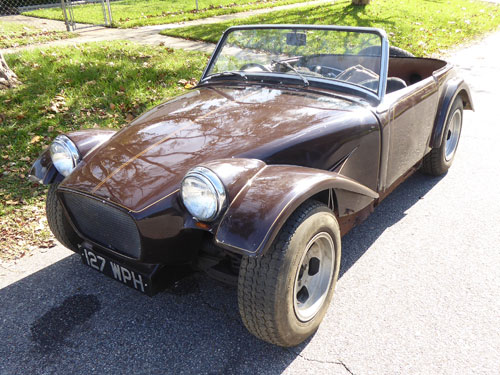
|
1962 Austin
Healey Sprite MK II (GIVEN AWAY 07/28/2020)
UK Professional Conversion |
|
| Download .PDF Resource Files at right |
Arkley Brochure
(3 MB) |
Cars & Car Conversions 1970 (2 MB) |
Classics Monthly Feb2010 (3.5 MB) |
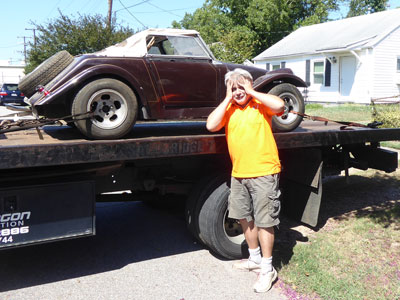 |
July 28, 2020 - Rehomed - After almost ten months with no progress on getting a title, plus the knowledge that most of the body repairs would have to be done by others, I gave the Arkley to Best Bud Chip and his son Ben. They would have been doing the welding work for me, and Chip loves the Midgets and Sprites that the Arkley is built on. Elwood, the same fellow who not only brought the Arkley to my house in the first place, but also has delivered a couple of cars to Chip's, did the transfer today. I am sure he is shaking his head over our obvious mental issues. At least Chip looks like he realizes what fools we are! |
| December 12, 2019
- More Parts
- The
flatbed driver who moved the Arkley called to let me know he'd come across a
rough Midget I might be able to get parts off. 'Rough' was a generous term,
but the car does have some good items. I had hoped to snag
floorboards, but close inspection today turned up rust holes that made
salvage of those impractical. On the other hand, the disc brake parts
are a direct bolt-on upgrade from the original drums, though it may be a bit
later. I snagged the top, seats, and some other small parts today.
The front suspension assemblies are next, with the gauges and a few other
items likely to join my stash. December 14, 2019 - Parted Ways - Today's visit scored the front suspension assemblies, plus some smaller items, with a great deal of assistance from Chip. The car turns out to have tube shock conversions front and rear, but the rears turned out to be too hard to pull given the car's precarious position on a trailer. |
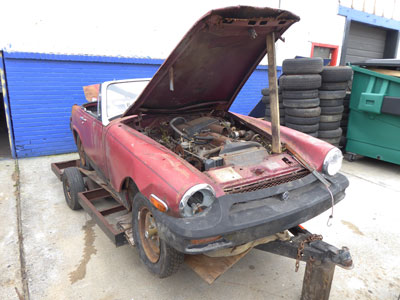 |
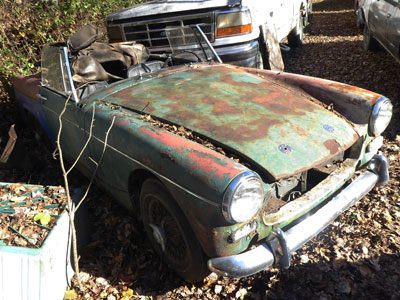 |
November 29, 2019 - Possible Parts - This mid-sixties MG Midget is located about 100 miles away and was the unwanted parts car for a 1965 Austin Healey Sprite the seller just sold. Why the buyer did not want this car is a mystery, since it is complete and has the identical running gear. Problems for me are that this is just enough newer that I can't really use the seats, instruments, or an of the other sheet metal. and I already have a spare engine. Also, it is a wire wheel car, which means it is no help for my disc wheel Arkley However, it does have some good parts and the floor pans might be salvageable. This is on hold while a later model Midget located close by get sorted and moved - the later Midget not only has the benefits of being a disc wheel car and located 20 miles away, it is also free! |
| November 16, 2019 - Carbs Happy - The Arkley just needed to have the idle screws adjusted to get down to a normal RPM, and it sounds great! I also got in the float valves and installed them with new bowl gaskets, which ended the leakage at the back carb. There is a YouTube video fo the engine running at: https://www.youtube.com/watch?v=LF666geJhg8 . One great benefit of messing with old cars in this day and age is that you can find almost anything. There were less than 900 Arkley kits ever made, so the number of actual cars surviving after 50 years is probably less than half that. Yet I was able to locate someone who still had reproduction decals for the car! UK Race Driver John Britten was the designer and manufacturer of the initial Arkley SS, and his logo was on every factory-built car. | 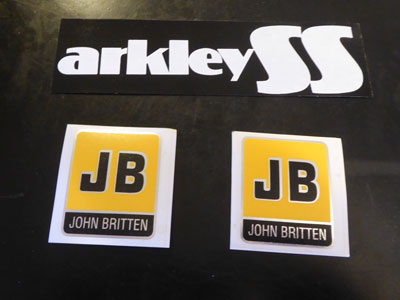 |
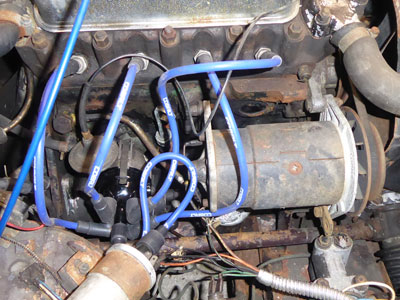 |
November 13, 2019 - Wired - Not much to report - I got in the Cobalt plug wires and distributor cap from Moss Motors and installed them tonight. The car fires right up and runs smooth, but I need to get the idle down to really tell much. I think the distributor has been changed out - the cap fits, but not the new rotor. |
| November 11, 2019 - Alive! - I have continued to tinker with the Arkley, installing a new fuel pump, fuel lines, and filters, and actually drawing from the tank. The engine continued to spit and stumble a bit, but wouldn't actually run. The back carb float valve was worn and dumping fuel, and I found out the new fuel pump was twice the pressure I needed. So I ordered another pump yesterday which arrived this morning, and Chip dropped off some good used needle valves. (I did order new parts from Moss, but didn't want to wait.) After swapping out for the low-pressure pump and the needle valve, I tried again. It still took a couple of tries, but the engine finally caught and then surged to a high, but steady idle! Oil pressure is 65, there was no smoke and no odd noises, and even the exhaust system sounds tight! The car starts with the first bump of the key now. It still needs to have the carbs adjusted to bring the idle down, but the Arkley is alive! | 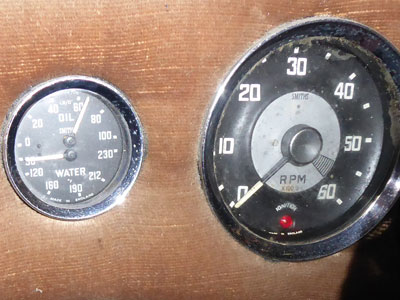 |
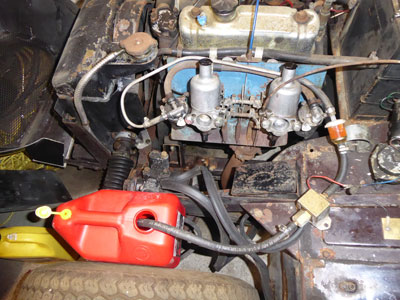 |
November 5, 2019 - Bigger Engine - Much progress tonight - the starter solenoid responded to cleaning and is now working with the key - she is trying to start but hasn't quite gotten running. Oil pressure is over 40 psi when she starts to catch! I was able to rig an old fuel pump and a gas can, but the pump diaphragm seems to have torn, which would explain the inability to start. A new pump is expected Thursday. I also started taking a closer look at the engine. I thought it was the original 948cc, but the 948 had a mechanical fuel pump, and this engine has a solid buss where the hole would have been. Also, the original engine had a take-off from the camshaft for the tach cable, which is missing on this car. The engine number tag is missing, typically lost when the block is machined during a rebuild. Lastly, the carbs are SU HS2 AUD136R, which were used on the 1964-68 Spridget 1098 and 1275cc engines. All of which indicates Poacher is powered by a rebuilt 1098cc engine! |
| November 4, 2019 - Power - I downloaded the wiring diagram and printed it out. With that in hand, I was able to connect the new ignition switch and have a start on power. An Arkley SS key fob arrived today from England, purchased a week before I actually owned the car. With power to the coil and distributor, I cranked her over with some starter fluid and got a couple of chuffs! Next up is getting the fuel pump working or installing a replacement. | 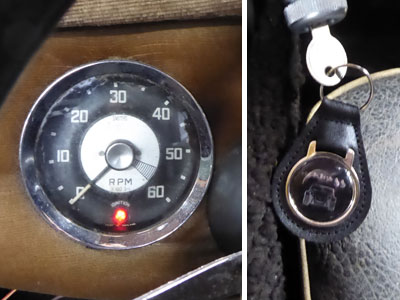 |
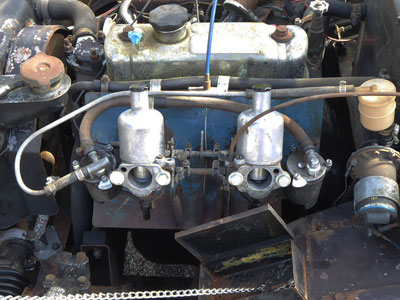 |
November 3, 2019 - Progress - The carbs are surprisingly clean and took only a bit of steel wool to move smoothly. I cleaned the plugs and points, topped up the cooling system, and blew out the fuel lines. The ignition switch was missing a key and a used replacement had been provided. Instead, I dug through the Morris Minor spares and found the new ignition switch I had bought and never used, still in the bag. I need to get a wiring diagram to hook it up properly, but once that is done, the last hurdle will be a fuel pump I have the one on the car and a used block pump that appears to work, so odds are I can try to start it soon. |
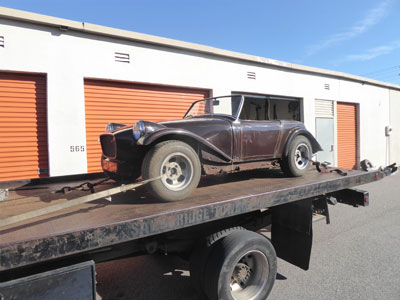 |
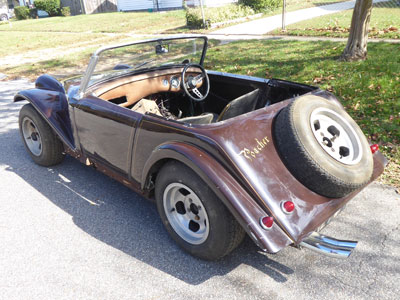 |
| November 2, 2019 - Home! - Poacher survived the flatbed ride to my house (I was actually worried it might arrive in two parts) and turned out to be in somewhat better condition than I first thought. While the floorpans and center bracing still looks scary, there is more metal than expected, and a lot of the important areas look solid. The dash is nice, and both the front and rear sections look rust free and complete. I particularly like the airbrushed poacher on the back of the car - if I get the car painted later I will try to save the artwork and lettering. Best Bud and Spridget enthusiast Chip examined the car for the first time and was immediately charmed. While he also sees a lot of work ahead in getting the body tub solid again, he is surprisingly confident that we can make it work (big emphasis on 'we', as I will have to lean heavily on his metal fabrication and welding skills.) Another pleasant surprise was being able to get the car in the garage - I spent most evenings this week cleaning and reorganizing things, and managed to not only get the Arkley in, but have enough space all around to use the workbench and toolbox, and work on both cars! That said, I also managed a little actual work on the car. I was able to crank the engine, and cleaned and tested the ignition switch which is out of the car. I also checked and cleaned the carburetor pistons (no corrosion!). The locking gas cap had no key, so I drilled it out enough to get it unlocked while still leaving the cap usable. There was fuel inside, and while it was obviously bad, it appears to be non-ethanol that hasn't turned to varnish. Possibly 35 years-old, unless someone tried to get the car going again in the meantime. Ironically, it was nowhere near as bad as the gas I pulled out of the Morris a month or so ago after just a couple of years. | |
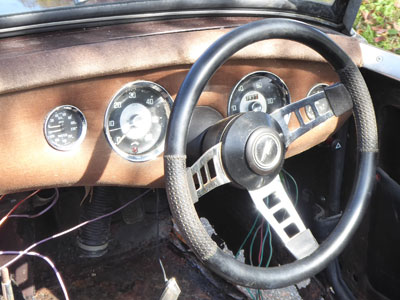 |
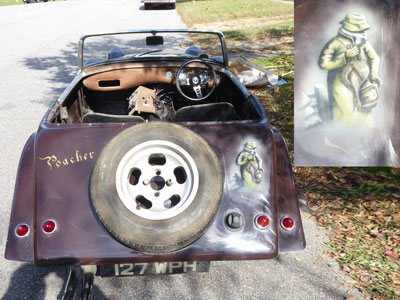 |
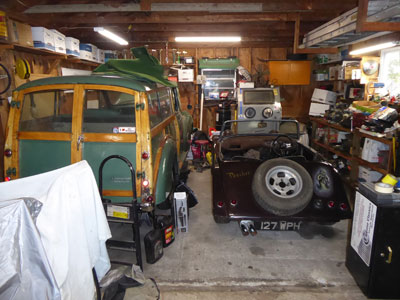 |
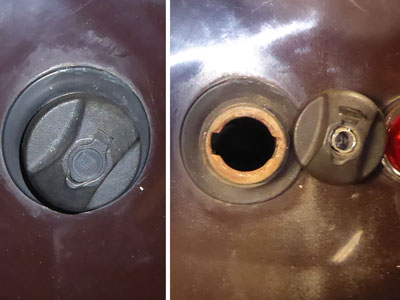 |
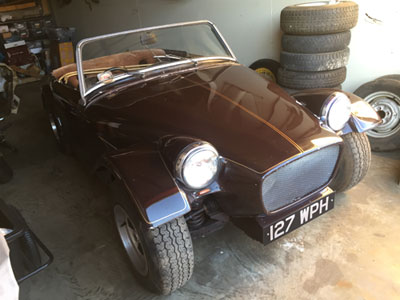 |
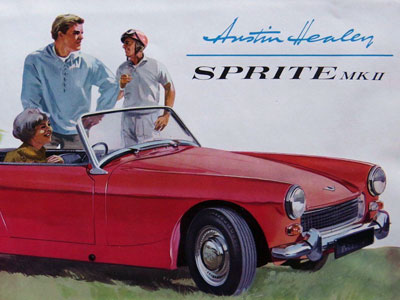 |
| October 27, 2019 - Coming soon to a driveway near me! - This 1962 Austin Healey Sprite MK II probably looks more than a little unusual. That's because it is an Arkley SS conversion, designed by British sports car racing driver John Britten in 1969 as a fiberglass front-end and rear-end body conversion to be fitted to the MG Midget or Austin-Healey Sprite (Spridget). When initially offered, there was a plentiful supply of battered or rusty Spridgets which could be economically resurrected by the Arkley conversion. The fiberglass sections were manufactured by the Lenham Motor Company at Harrietsham in Kent, and improved performance over the original car due to lighter weight and wider tires. Arkley's were sold either as do-it-yourself kits or as turnkey conversions constructed in Britten's Arkley Engineering workshop in Hertfordshire. The business was sold to Peter May in 1987 and continued production until 1995, with molds and kits still available in the UK and the US. However "Spridgets" have become valuable classics on their own and are usually restored to their original configuration. This means that while there are still some of about 900 total Arkley conversion kits still unbuilt and available, few people are willing to sacrifice a Spridget to build a new one. | |
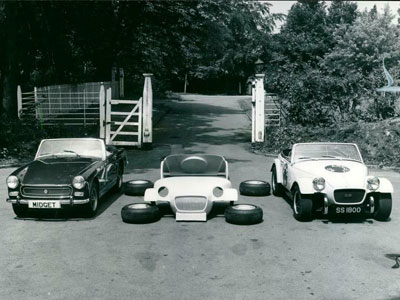 |
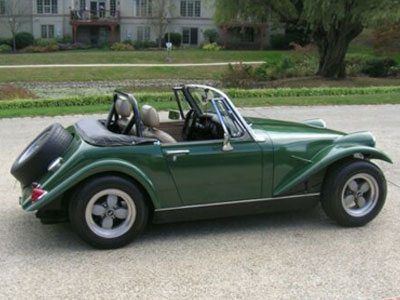 |
| Poacher was built December 1961, and first registered in Surry UK January 1962. At some point in its later years, the car was used for an Arkley SS conversion. Although the later Spridgets with the roll-up windows and modern windshield were far more commonly converted to Arkleys, the early series flat windshield and side curtains really lock in the vintage look of the Arkley's simple design. The car was obviously professionally built, with really impressive paint, pin striping, and airbrushed lettering and art. It was on the road until May of 1984, when UK road tax was no longer paid. Unfortunately, despite being stored somewhere that protected the paint and components, the floor of the body tub was almost totally rotted out. Despite that, the car was not scrapped, or stripped of a single component. Even the top and side curtains stayed with the car as it ended up as part of a package deal sold to an American vintage sports car racer. The car sat in storage for a while, until the vintage racer determined he didn't want to do anything with the Arkley and advertised it to the local MG Club. It wasn't until lack of interest from others caused a substantial price drop that I came into the picture. Understand that I don't have space for much of anything else, but the unique nature of the Arkley snagged my interest. The car looked really good at first glance - until I saw the interior. Or more accurately, the concrete beneath the car. There was a pretty even mix of rust and air where floorboards and side rails were supposed to be. I took the photos displayed here and did some research. A thought of transferring the Arkley components to a late model Midget were abandoned after reading about the way the back is fiberglassed to the Spridget body. Plus, the RHD early car's look would be nearly impossible to duplicate. Best Bud Chip (Yes, I am publicly blaming you) ventured the opinion that Spridget floors are much easier to deal with than the MGBs we are both used to, and also showed me a new argon MIG welder in his garage. That information, plus a drastically reduced price, convinced me to go ahead and take a chance. I bought the Arkley with the known risk that I may not be able to repair it. At worst, I'll get some good experience in welding and mechanical parts that fit my Morris Minor. With some luck, however, I'll have a very unique little sports car that will be a lot of fun to drive. | |
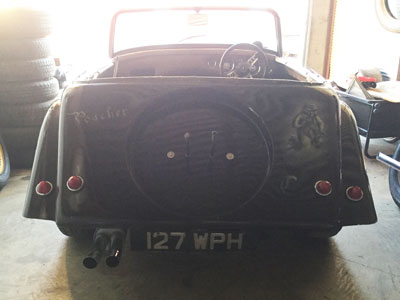 |
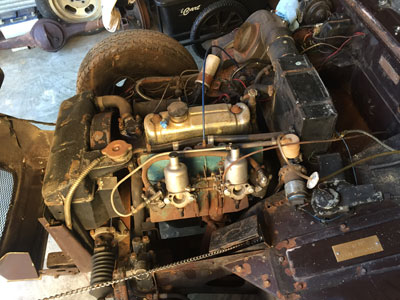 |
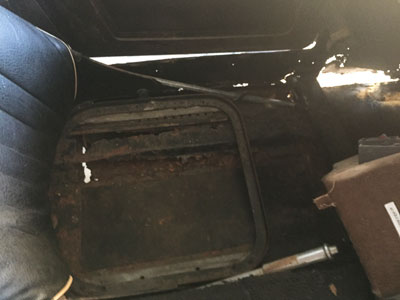 |
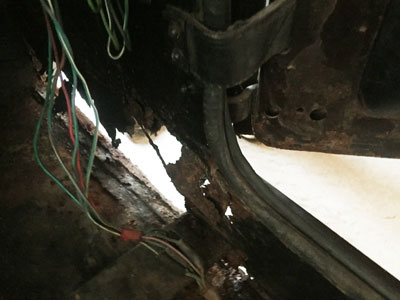 |